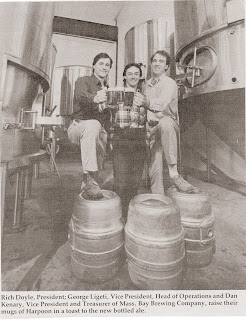Somewhere south of Boston, there exists what I can only
describe as my version of a man-cave (OK: woman-cave too). It is a
finished basement featuring stacks of wine crates full of amazing wines;
wall-to-wall temperature controlled racks; and one of the best whiskey
collections I'll never be able to afford.
Out of respect of his privacy and the value of his treasure
trove of wine and whiskey, I agreed to not disclose the location or the man who
owns this basement of potable wonders. Let's just refer to him as "Mr. Good
Spirit".
Mary and I've just recently made Mr. Good Spirit's
acquaintance, and every now and then he invites us and friends over to
"assist with his inventory problem". We are always happy to oblige.
 Just last week he had me and good friends over for just such
an occasion. Upon arrival we were greeted with wine flutes filled with Harpoon
Winter Warmer, and a table prepared with cheeses and other savory treats. He also had opened some very special wines: a
1985 Bordeaux Mouton Rothschild; a 1991 Napa Valley Dominus (in the Bordeaux
style); and a 1994 Dominus. We concluded the evening with a “wee dram” of
Springbank Scotch Whisky.
Just last week he had me and good friends over for just such
an occasion. Upon arrival we were greeted with wine flutes filled with Harpoon
Winter Warmer, and a table prepared with cheeses and other savory treats. He also had opened some very special wines: a
1985 Bordeaux Mouton Rothschild; a 1991 Napa Valley Dominus (in the Bordeaux
style); and a 1994 Dominus. We concluded the evening with a “wee dram” of
Springbank Scotch Whisky.
It was all fantastic, and we had lots of great conversation about the beer, wine and whisky, comparing notes on each of our interpretations of them. The crafts men and women who make our favorite potent potables work very hard at combining ingredients and process to provide a unique flavor experience, and its sort of fun to "geek-out" every now and then about how they might have approached making their offerings.
One of the things that I learned in my final year at U.C. Davis when I took a course called
“Sensory Evaluation of Wines” is that each person interprets
flavor in their own unique way: the perception of flavor is not only dependent
upon the actual wine presented, but also upon a person's senses, how that person interprets flavor in their brain, and finally, the influence of what is going on in the environment around them at the time. A great wine can be made difficult to remember as so if there is a lot of external stimuli going on during the tasting, and a good wine will be remembered as great if it gets associated with a fun evening out with friends and family. It all sounds sort of complex, but it doesn't have to be.
Folks new to wine might be intimidated when sharing and
conversing about wine in this way, but there is a basic framework in the way to
approach it. Use all your senses: eyes, nose, taste,
touch, and hearing. They all contribute
to the experience of flavor.
Eyes
When you look at the glass of wine, the hue, depth, and
intensity of the color provide some clue as to not only what grapes were used,
but also how old the wine might be.
Cabernets and Bordeaux styles tend to be deep red in color; Pinots less
so. Newer red wines tend to have bright
red colors; older wines tend to have more “brick-red” colors, and sometimes browning
at the edges of the surface of the wine.
Nose
When you swirl the wine in the glass it intensifies the
aromas and fermentation bouquet in the headspace of the glass. Take a deep sniff. Among the things that you might detect in
that sniff are different types of fruit, butter, vanilla, spice, black pepper,
green pepper, etc. That’s not the whole
list, but those are some of the more common ones.
Taste and Touch
As you drink the wine, there is an interplay going on
between your basic flavor senses (sweet, salt, bitter, sour); the way it feels
in your mouth (thick, thin, puckering), and some additional aromatics that will
creep up the back of your mouth into your nose as the wine warms in your mouth.
Hearing
This one is simple: listen to the words of what other
people are using to describe the wine.
It will help to anchor your mind’s frame of reference for picking out
the individual notes from the symphony of flavor that you will experience.
Share
 Most importantly, share your experience with your family
and friends. It is how social networking
was originally intended.
Most importantly, share your experience with your family
and friends. It is how social networking
was originally intended.

.jpg)






